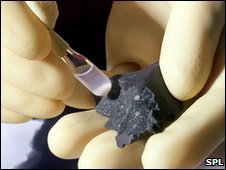Space rock contains organic molecular feast
|
By Doreen Walton
Science reporter, BBC News
|


The Murchison meteorite came down in Australia in 1969
|
Scientists say they have confirmed that a meteorite that crashed into earth 40 years ago contains millions of different organic compounds.
It is thought the Murchison meteorite could be even older than the Sun.
"Having this information means you can tell what was happening during the birth of the Solar System," said lead researcher Dr Philippe Schmitt-Kopplin.
The results of the meteorite study are published in the Proceedings of the National Academy of Sciences.
"We are really excited. When I first studied it and saw the complexity I was so amazed," said Dr Schmitt-Kopplin, who works at the Institute for Ecological Chemistry in Neuherberg, Germany.
"Meteorites are like some kind of fossil. When you try to understand them you are looking back in time," he explained.
The researchers says the identification of many different chemicals shows the primordial Solar System probably had a higher molecular diversity than Earth.
The Murchison meteorite landed in a town of that name in Australia in 1969. It has been examined before by scientists looking for specific compounds but this is the first non-targeted analysis and has confirmed a huge variety of carbon-based chemicals.
A study using high resolution analytical tools including spectroscopy allowed the team to identify 14,000 different compounds including 70 amino acids in a sample of the meteorite.
They extrapolated this on the basis of knowledge of how similar organic molecules are arranged in space and calculated that the meteorite should contain several million different chemicals.
But the analysis technique is still limited, as Dr Schmitt-Kopplin explained: "We have to crush a few milligrams from the core of the meteorite to enable the extractions with solvents and thus we only see the extractable fraction."
"In addition we are only seeing the ions we can generate with the ionisation source of our mass spectrometer. With different types of ionisation sources we could see even more."
Burning question
Scientists believe the Murchison meteorite could have originated before the Sun was formed, 4.65 billion years ago. The researchers say it probably passed through primordial clouds in the early Solar System, picking up organic chemicals.
Dr Schmitt-Kopplin hopes the findings might contribute to the debate over how life on Earth originated.
"I guess many people working in these fields with access to this knowledge will have some further hypothesis and will possibly be having some of their hypotheses confirmed."
"Where did we come from and what happened before? We all have that question inside us."
The team is also analysing other meteorites but say Murchison is probably the most complex they have studied. | 